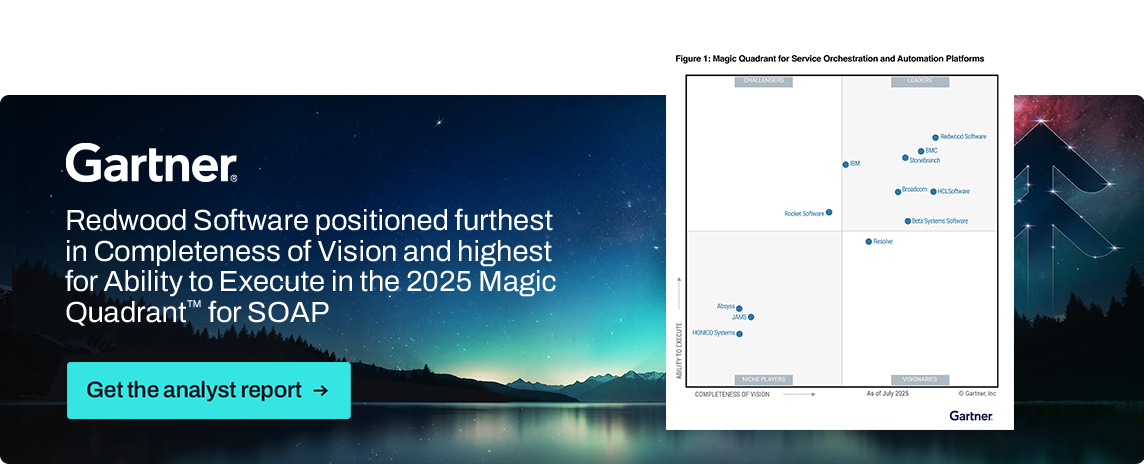Gartner® automation trends for 2026 and beyond
Every fall, Gartner drops its list of strategic technology trends, and you can almost feel the industry exhale. Not because the trends are surprising, but because the list gives shape to what teams have been sensing all year. In 2026, that picture is sharper: automation isn’t surrounding the business anymore. It is the business. Or at least the part of it that holds everything else together.

Every fall, Gartner drops its list of strategic technology trends, and you can almost feel the industry exhale. Not because the trends are surprising, but because the list gives shape to what teams have been sensing all year. In 2026, that picture is sharper: automation isn’t surrounding the business anymore. It is the business. Or at least the part of it that holds everything else together.
You can see the shift in the language Gartner uses about the automation market. Instead of talking about isolated tools, the trends lean toward systems that can interpret their environment, negotiate decisions and collaborate with other advanced technologies.
Multi-agent systems. Domain-specific models. Preemptive security. Even physical AI. Automation is caught in the middle of all of this as the connective infrastructure that makes the rest possible.
The latest Gartner® Magic Quadrant™ and Critical Capabilities for Service Orchestration and Automation Platforms (SOAPs) echo that same theme. Leaders are no longer defined by how many repetitive tasks they automate. They’re defined by how well they coordinate distributed, data-heavy, often unpredictable operations — and how gracefully they scale as those operations change. What follows is a field-level view of how these trends echo inside IT, where orchestration is becoming something closer to operational choreography.
Top IT automation trends — and what they mean for real-world outcomes
A few years ago, you could still hear people say “automation is an initiative.” By now, that sounds quaint. For many organizations, automation is the scaffolding that holds digital operations upright. And if the last few years were about adoption, 2026 is about cohesion: stitching everything together so workflows function as a system, not a patchwork.
Hybrid IT orchestration is essential
Hybrid IT has been the default for so long that it barely feels worth mentioning, but its impact on automation keeps growing. Most enterprises still rely on aging on-premises systems for revenue-critical work, while cloud services multiply around them. Somewhere in between, workloads bounce among providers, containers, APIs and integrations stitched together at various points in time.
This isn’t inherently bad. Hybrid environments give teams freedom, and freedom often beats purity. But the complexity that comes with it? That part is real. Anyone who has ever chased down a slow-running data job that disappears at the boundary between two systems knows this is true.
Industry research, including from Gartner, reflects this reality: organizations are running across more providers, not fewer. And because of that, orchestration has become the glue. It’s less about timing and more about awareness — understanding what depends on what, when and under which conditions.
If 2025 was about getting visibility across environments, 2026 looks like the year organizations demand consistency: advancements in security policies, error handling, compliance controls, even naming conventions. Modern orchestration platforms are better at enforcing those patterns than a dozen platform-specific schedulers ever could be.
AI and data pipeline orchestration are converging
A lot of people talk about AI as if it lives in the model itself — the large language model (LLM), the classifier, the recommendation engine. But the real action tends to happen in the layers around it: the pipelines that collect, clean, shape and deliver the data that fuels the model.
What’s changed is the pace. There was a time when a nightly batch was enough. But not now, when fraud detection models adapt hourly. Not when supply chains adjust to weather patterns or geopolitical news. And not when customer experience relies on personalized recommendations that update every time a user so much as hovers over a button.
Orchestration sits squarely in this intersection. It enforces the sequencing of data movement, ensures pipelines don’t outpace their sources and acts as traffic control when AI models demand inputs faster than a human could intervene. Gartner calls out multi-agent systems and AI-native platforms in its 2026 trends, and this is where those ideas land in practice. AI-powered automation solutions won’t be “intelligent” without orchestration that keeps the lights on behind the scenes. The model is only as good as the plumbing.
Low-code and no-code tools fuel accessibility
There’s a quiet shift happening inside organizations. It’s not the big AI platform decisions or the cloud migrations. It’s the simple fact that more people can automate their own work. Finance teams, HR coordinators, operations analysts and department heads who would never describe themselves as technical.
Low-code and no-code tools made this possible, and Gartner expects their footprint to keep expanding. It’s not because IT is stepping back, but because business teams are finally comfortable stepping in. When the alternative is submitting a ticket and waiting three weeks for a small workflow tweak, the motivation becomes obvious.
Of course, this kind of freedom comes with its own physics. Without guardrails, it’s easy to end up with five versions of the same process or automations that quietly break when someone leaves the company. That’s where orchestration platforms come back into focus — not to take control away, but to give the business safer sandboxes to build in. The organizations doing this well treat low-code not as an escape hatch from IT but as a collaboration channel with it.
Automation-as-a-Service (AaaS) models are growing
You can see this one coming from a mile away: when every other part of the stack is shifting to a service model, automation won’t stay on-prem forever. Gartner language around AI supercomputing platforms and confidential computing reinforces that the infrastructure underneath AI and automation will be increasingly abstracted — and increasingly out of sight.
AaaS is appealing for reasons that have very little to do with cost. Teams like the elasticity, the automatic updates, the integrations that appear without a lengthy upgrade cycle and the sense that the tool is evolving in the background even while they work. That said, many organizations continue to run automation on-prem or in hybrid environments for control, customization or data governance reasons, and the industry is trending toward models that support both approaches rather than forcing a single deployment path.
And, perhaps most importantly, AaaS models lower both operational friction and organizational resistance. When automation doesn’t require a hardware refresh or a maintenance freeze, conversations about scaling become a lot easier.

Enterprise-scale process orchestration is accelerating
What people used to call “hyperautomation” has taken on a different tone. The trend still exists, but its center of gravity shifted. Instead of automation expanding one tool at a time, organizations are trying to choreograph entire systems — applications, data flows, physical devices, even AI agents — so they operate with a kind of collective logic.
This is where the rubber meets the Gartner trend of physical AI. Robotic systems, drones and smart sensors are increasingly being stitched into operational workflows and not treated as side projects. Manufacturing lines are already seeing this: robots move in response to quality, real-time data, not just fixed programming.
Elsewhere, financial reconciliation workflows are now chains of decision steps: document extraction → validation → exception routing → AI scoring → settlement. None of that works without orchestration that can handle the jumps between tools, teams and data sets.
The latest Magic Quadrant™ for SOAP report makes the same point through a different lens. Organizations don’t want 12 disconnected automation systems. They want orchestration that sees across the landscape and governance that keeps it from turning into an unmanaged maze.
Cloud-native and API-first solutions dominate
If you draw all the trends together — hybrid environments, AI data needs, AaaS adoption — the outcome is obvious. Cloud-native automation is becoming increasingly important as workloads spread across environments. It’s the only architecture flexible enough to handle constantly shifting requirements. Even so, plenty of enterprise workflows still run on-prem or in private clouds, and some modern automation platforms support all of it, not just cloud-first architectures.
But cloud-native alone isn’t the kicker. API-first design is what unlocks the scale. Without it, automation is just a fancier form of scripting. With it, automation becomes connective tissue: the way ERP systems pass data to analytics engines, the way customer platforms sync with marketing flows and the way governance rules stay aligned across federated environments.
Gartner’s 2026 trends mention digital provenance and geopatriation, two areas where data lineage and location matter more than they used to. API-first architectures make that easier, not harder, because they give automation platforms the hooks needed to enforce policy instead of bypassing it.
In short, cloud-native automation is less about where it runs and more about how seamlessly it plugs into everything else.
The shift to intelligent automation
Automation started as a way to make life easier. Intelligent automation is starting to make organizations smarter, sometimes in ways that surprise them. By combining robotic process automation (RPA), AI and interpretation layers (like natural-language processing and computer vision), workflows can take on decisions that once required a person.
But intelligent automation isn’t magic. It’s a matter of inputs, structure and context. And it thrives when orchestration provides the rails.
What is intelligent automation, and why does it matter?
Intelligent automation is the step between rule-based automation and full autonomy. It blends structured logic with cognitive elements, such as the ability to sort unstructured documents, anticipate exceptions or converse in natural language.
Picture an insurance workflow: a claim arrives, gets scanned, interpreted, classified, checked against policy rules, flagged for risk and routed to the right adjuster. Ten years ago, that process would have required a floor of people. Today, orchestration manages the sequence, automation performs the steps and AI handles the interpretation.
The “intelligent” part means freeing people from the mental clutter of repetitive, low-value work so they can focus on the situations that actually need judgment.
Benefits of embracing intelligent automation
Organizations that embrace intelligent automation tend to describe the impact in practical terms rather than glossy metrics. They talk about:
- Fewer backlogs
- Shorter cycle times
- Less context-switching
- Cleaner audit trails
- More thoughtful, data-driven decisions
Gartner ties intelligent automation directly to digital transformation — not the buzzword version, but the version where processes behave as though they understand what they’re doing. When workflows can adjust themselves, the business becomes far less fragile.
The future of intelligent automation
In 2026, the conversation turns from generative AI toward multi-agent systems, AI copilots and orchestration layers that support them. You don’t need every workflow to be autonomous. You just need the environment to support autonomy where it makes sense.
Self-healing processes, for example, are becoming more realistic. If a job fails because of a locked file or a transient network issue, the system can try alternate paths instead of waking up an engineer at 2 AM. Ultimately, organizations won’t measure maturity by how many automations they’ve deployed but by how coherent those automations feel together.
Implementing automation in an AI-focused world
For all the momentum, the old challenges haven’t disappeared; they’ve just shifted shape.
Change resistance still shows up, though it’s less about fear of replacement and more about discomfort with unfamiliar tools. Legacy systems remain stubborn despite their long list of potential issues, often because the documentation is long gone or the one person who understood them retired two CIOs ago. And security continues to tighten its grip, especially as automation touches sensitive interdepartmental data.
The companies that move past these hurdles tend to treat automation as a capability, not a project. They socialize it. They govern it, build the muscle for it. And because of that, they adapt more quickly to whatever comes next.
How ActiveBatch helps you put the latest trends into practice
Redwood Software was named a Leader for the second consecutive year in the 2025 Gartner Magic Quadrant™ for SOAP, positioned highest for Ability to Execute and furthest in Completeness of Vision.
ActiveBatch by Redwood turns those strategic trends into something usable for your use cases:
- Orchestration that spans clouds, legacy systems and data pipelines
- Real-time monitoring, observability and early-warning signals
- Built-in governance to keep automations consistent as they grow
- Low-code workflow design for approachable, cross-team building
- Deep integrations with SAP, Informatica, Azure, AWS, Oracle and more
It’s orchestration built for complexity, without the weight that typically comes with it. Book a demo today to find out how it could revolutionize your enterprise’s approach to automation.
Ready to see how we make workload automation easy?
Schedule a demo to see how easy it is to build and maintain your jobs in ActiveBatch.
Frequently Asked Questions
IT automation is a broad field that includes everything from job scheduling to infrastructure management. IT task scheduler software can be used to develop, monitor, and manage automated tasks that support intelligent process automation, data center automation, IT infrastructure, secure file transfers, software development, and much more. Explore our in-depth IT automation explainer.
Automation is being used to reduce time-consuming manual processes needed to manage surges in data and digital tools. In order to increase efficiency, organizations are implementing hyperautomation initiatives and using artificial intelligence and machine learning to streamline, monitor, and manage automated processes. Overall, intelligent process automation technologies are becoming central to process orchestration goals within IT and business departments. Learn more about automation and orchestration. Learn more about automation and orchestration.
Gartner’s top automation predictions for 2023 include growth in hyperautomation, IT systems becoming increasingly critical as organizations rely on business process automation to deliver digital experiences, and new data storage and compute technologies as a result of organizations reaching a digital wall. Read the full breakdown of Gartner’s 2022 IT automation predictions.







